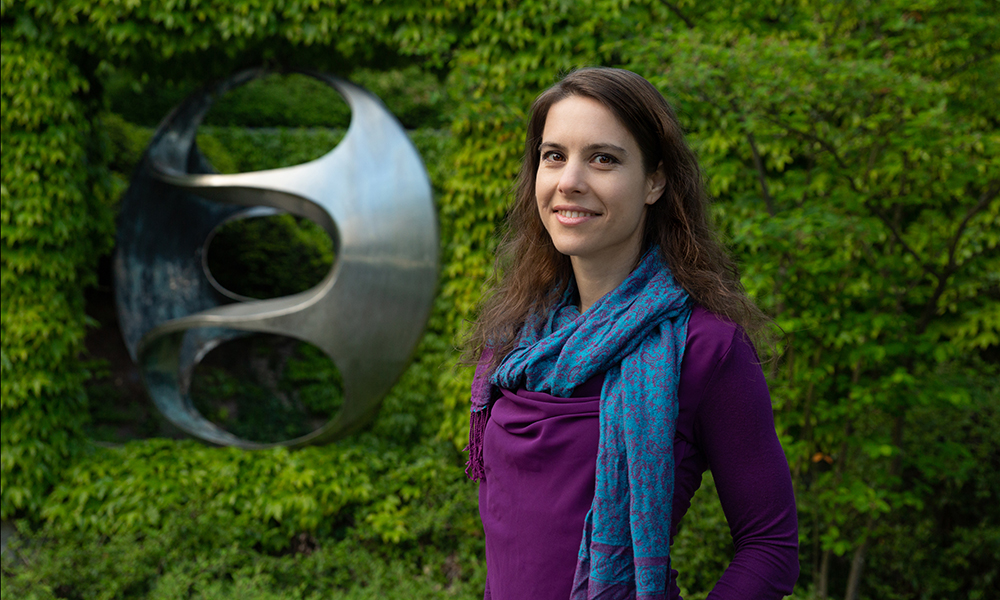
Welcome: Georgia Rapti
New group leader is exploring the development of the nervous system in early embryos

The nervous system has fascinated Georgia Rapti ever since her first introduction to biology. Her research group in the Developmental Biology unit will focus on understanding the early biological events involved in the nervous system’s formation.
Tell me about your scientific background. How did you become interested in science?
As a child I was always captivated by natural phenomena and the unknown, and all the thinking that this provokes. This was nurtured by my parents, who are both scientists. My father is a physicist, and he did a lot of experiments at home – to show light refraction through a prism or to explain pendulums, for example. I was always very interested in this process of solving a problem. As a teenager, I would spend hours solving problems in math, and I really enjoyed that. When I discovered biology, I felt that it was a rather young science, with many more questions than answers. I was particularly fascinated by the nervous system from early on. For my bachelor’s degree, I worked with Alzheimer’s proteins and molecular mechanisms. I went on to do a master’s and PhD on the modulation of synaptic neurotransmission. In my postdoc, I decided I would step back and try to understand how the nervous system forms in the first place – the very early events.
What will your group focus on at EMBL?
We’ll focus on understanding how the nervous system forms in the early embryo, and identifying the different molecular and cellular steps that drive the very first events of making neural networks and circuits. There are many unknowns. We’ll be taking different approaches in the lab, combining advanced imaging with molecular, genetic, and genomic approaches – all in live embryos. We’ll study the interactions between the very early cells that actually start building up the system. The nervous system is composed of neurons – which are very well known – and glial cells, which were underappreciated for a long time. We now know that glial cells actually have pivotal roles in both the development and function of the nervous system. We have identified, for example, specific glia and specific neurons with unique identities that start interacting very early to build the nervous system. In the lab, we will focus on the interactions of glia and neurons to build the structure of the brain.
What most excites you about doing science at EMBL?
EMBL is a place that combines cutting-edge science with intellectual people who are always eager to interact, and will always find the time, the energy, and the motivation to bounce ideas around, give feedback, mentor, and create collaborations. This combination is very special, and it’s one of the most exciting things about being at EMBL.
How have you found the transition from postdoc to group leader?
It’s a very stimulating transition. It’s also challenging at times. It’s the first time you have the opportunity to set up a lab in the way you desire – but you have to keep a balance between the organisational aspects and the scientific thinking. In this transition phase, this balance needs to be reassessed every day. Fortunately, there’s a lot of organisational support at EMBL, throughout all departments, and this is extremely important. At the same time, I’m surrounded by people who are very open to discussion, and my new lab members are very motivated. This helps me to keep the balance – it’s a very fertile environment for scientific discussion.
What’s your philosophy for running your lab?
Having people who are curious, open-minded, and motivated – this is necessary for scientific progress, in my opinion. There will always be hardships and there will always be failures, because that’s how it is with research of the unknown. Practically, there’s a lot of experimental failure, but I think having the goal of understanding something, combined with the motivation for hard work, can give the answers. We also have to keep in mind that it’s the responsibility of every single lab member to build an environment that promotes scientific thinking and is also good for our well-being. We have to build that together.
How do you balance work and life as a scientist?
My life is very much balanced between science and art. I started classical and modern dance when I was six years old, and since then I’ve always kept this balance. It wasn’t easy to do, through different countries and different scientific environments, but it has proven to be extremely important. For me, science has always demanded very hard work, but having breaks in the quest for scientific progress was always very important for creativity and new ideas. Art is very similar to science, in that it demands a lot of creativity and self-discipline, and I think this helps my progress in science as well. I always try to keep a balance between my work in science, and art, travel, and family. As a neuroscientist, I have to acknowledge that keeping a healthy balance also has a positive effect on hormones – so it’s also biologically relevant.
If you weren’t a scientist, what would you be?
This is a tough question, because I’m interested in many things. But I think I’d be an artist. I see many commonalities between art and science. In my opinion, they are both, to some extent, about understanding the unknown – whether in nature or in human thinking and emotions.


